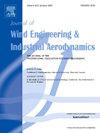Suppression of multi-mode non-planar rain-wind-induced vibrations of stay cables: Scruton number threshold and optimal damper design
IF 4.9
2区 工程技术
Q1 ENGINEERING, CIVIL
Journal of Wind Engineering and Industrial Aerodynamics
Pub Date : 2025-08-04
DOI:10.1016/j.jweia.2025.106196
引用次数: 0
Abstract
Suppressing cable vibrations should address energy dissipation by dampers and energy input from the air. In this study, a methodology framework is proposed to efficiently suppress wind-induced cable vibrations with dampers. In this framework, the Scruton number (Sc) threshold is clarified by identifying amplitude-dependent aerodynamic damping in on-site environments; on this basis, the damper is optimized by solving eigenfrequencies of the cable-damper system with a multi-objective genetic algorithm. This framework is applied to deal with the multi-mode non-planar rain-wind-induced vibrations (RWIV) of an ultra-long stay cable on the Sutong Bridge. Firstly, two typical RWIV events observed during one-year field monitoring are reported through the evolution analysis of decomposed modal responses. Then, a scheme of bi-directional viscous dampers combined with a high-damping rubber (HDR) damper, as optimized in location and size, is implemented to mitigate the vibrations. The results suggest a tentative threshold of Sc > 12.5 for both in-plane and out-of-plane modes within the frequency range of 1.9–3.6 Hz to prevent the RWIVs of the cable. The effectiveness of the optimized dampers in mitigating the RWIVs is demonstrated through on-site monitoring.
斜拉索多模态非平面风雨振动抑制:斯克鲁顿数阈值与最优阻尼器设计
抑制电缆振动应解决阻尼器的能量耗散和空气输入的能量。在这项研究中,提出了一种方法框架,以有效地抑制风致缆索振动与阻尼器。在这个框架中,通过识别现场环境中与幅值相关的气动阻尼,明确了斯克鲁顿数(Sc)阈值;在此基础上,利用多目标遗传算法求解索-阻尼器系统的特征频率,对阻尼器进行优化。将该框架应用于苏通大桥超长斜拉索的多模态非平面风雨激振。首先,通过分解模态响应的演化分析,报道了1年野外监测中观测到的2个典型RWIV事件。然后,通过对阻尼器的位置和尺寸进行优化,实现了双向粘性阻尼器与高阻尼橡胶阻尼器(HDR)的组合方案。结果表明Sc >是一个暂定阈值;在1.9 ~ 3.6 Hz的频率范围内,面内模式和面外模式均采用12.5,以防止电缆的RWIVs。通过现场监测,验证了优化后的阻尼器在缓解RWIVs方面的有效性。
本文章由计算机程序翻译,如有差异,请以英文原文为准。
求助全文
约1分钟内获得全文
求助全文
来源期刊
CiteScore
8.90
自引率
22.90%
发文量
306
审稿时长
4.4 months
期刊介绍:
The objective of the journal is to provide a means for the publication and interchange of information, on an international basis, on all those aspects of wind engineering that are included in the activities of the International Association for Wind Engineering http://www.iawe.org/. These are: social and economic impact of wind effects; wind characteristics and structure, local wind environments, wind loads and structural response, diffusion, pollutant dispersion and matter transport, wind effects on building heat loss and ventilation, wind effects on transport systems, aerodynamic aspects of wind energy generation, and codification of wind effects.
Papers on these subjects describing full-scale measurements, wind-tunnel simulation studies, computational or theoretical methods are published, as well as papers dealing with the development of techniques and apparatus for wind engineering experiments.

 求助内容:
求助内容: 应助结果提醒方式:
应助结果提醒方式:


